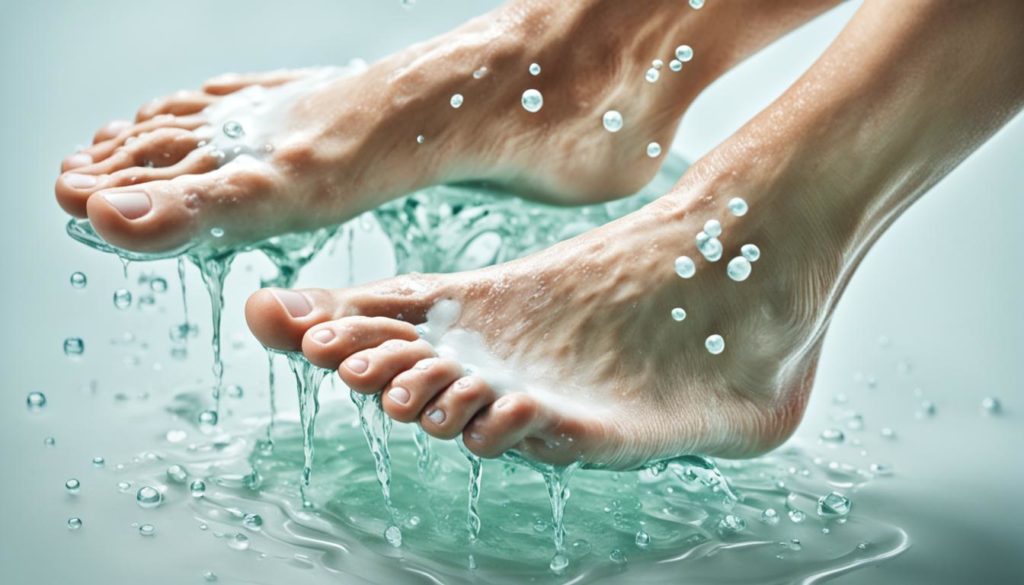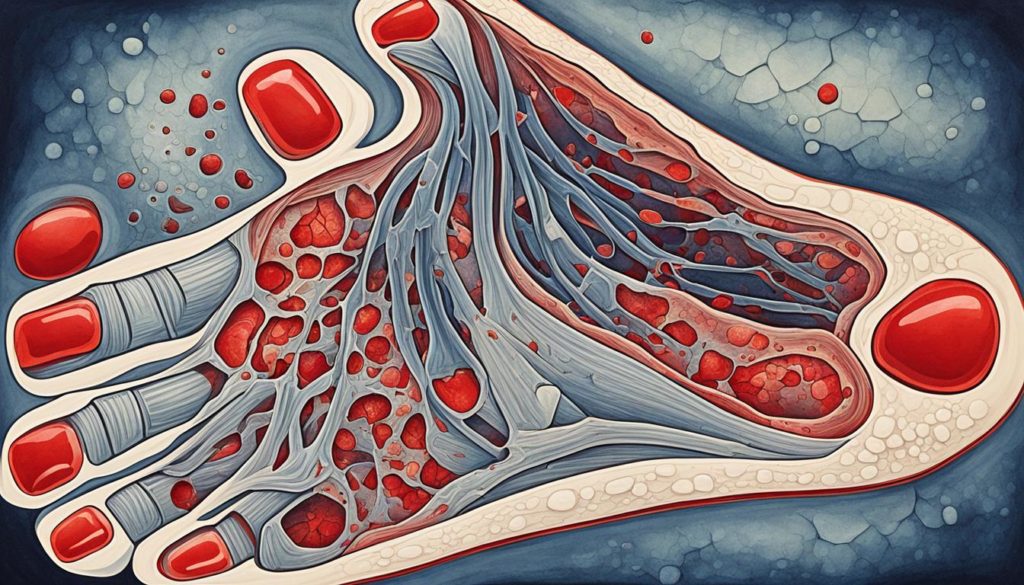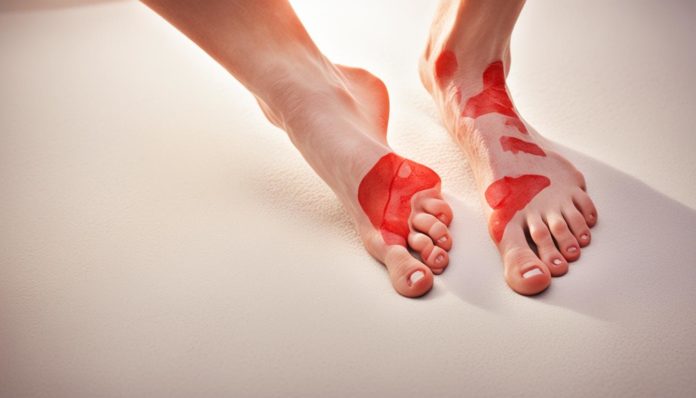Did you know that over 70% of people will get athlete’s foot at some point? This surprising fact shows how common this fungal foot infection is. It is also known as tinea pedis. It mostly affects the skin on the feet and sometimes the toenails too.
Athlete’s foot comes from various dermatophytes. These fungi love warm, moist places like gym locker rooms and swimming pools. People with this infection feel itching, stinging, and burning on their feet. Luckily, treating it usually means using antifungal meds, keeping feet clean, and making some lifestyle changes to avoid it coming back.
Key Takeaways
- 70% of people will experience athlete’s foot at some point.
- Athlete’s foot, or tinea pedis, affects the skin and toenails.
- Caused by dermatophytes, fungi that thrive in moist environments.
- Common symptoms include itching, stinging, and burning sensations.
- Treatment involves antifungal medications, hygiene practices, and lifestyle adjustments.
Introduction to Athlete’s Foot
Athlete’s foot is a common skin issue that often starts between the toes. It’s highly contagious and uncomfortable. That’s why it’s key to stop it before it starts.
Look out for itching, stinging, and burning in your feet. Your skin might also get dry, flaky, and crack. Catching and treating these symptoms early helps stop the infection from getting worse.
There are many ways to treat athlete’s foot. For mild cases, creams, sprays, and powders you can buy at the store work well. If it’s serious, you might need prescription medicine.

To avoid catching athlete’s foot, good hygiene is crucial. Keep your feet clean and dry. Choose shoes that let your feet breathe. And don’t walk barefoot in places like locker rooms.
Knowing the signs of athlete’s foot and how to treat it helps keep your feet healthy. This knowledge prevents the infection from coming back, ensuring you recover quickly.
What is Athlete’s Foot?
Athlete’s foot is a common skin issue that starts between the toes. It loves warm, damp places. People with sweaty feet in snug shoes often get it.

Definition of Athlete’s Foot
Athlete’s foot, also called tinea pedis, is a foot skin infection. It comes from different fungi, like Trichophyton. These fungi also cause ringworm and jock itch. You can catch it by direct skin contact or by using things like floors, towels, and shoes that have the fungi on them.
Common Misconceptions
There are many myths about athlete’s foot. One is that only athletes get it. But the truth is, anyone can catch it if fungi can grow. Another myth is thinking it’s all about poor hygiene. Sure, keeping clean helps fight it off. Yet, tight shoes and sweaty feet also contribute.
It’s important to clear up these myths. This way, people can better prevent and treat athlete’s foot.
Causes of Athlete’s Foot
Athlete’s foot mainly comes from fungal infections. These fungi love moist places. Knowing where these infections come from helps us prevent and treat them.
Fungal Species Involved
The culprits of athlete’s foot are mostly dermatophyte fungi. Trichophyton, Epidermophyton, and Microsporum are to blame. They target areas rich in keratin like our skin, hair, and nails. This leads to the annoying itching and flaking of the skin.
Transmission Methods
Athlete’s foot spreads mainly through touching infected people or dirty surfaces. Lockers, pools, and shared showers are hot spots for these fungi. Using someone else’s towel, socks, or shoes can also spread the infection.
Risk Factors
Going to damp, shared places a lot increases your chance of getting athlete’s foot. So does sharing personal stuff, wearing tight shoes, and having weak immunity. These factors make it easier for fungi to grow, raising your risk.
| Fungal Species | Common Environments |
|---|---|
| Trichophyton | Locker rooms, swimming pools |
| Epidermophyton | Communal showers, gyms |
| Microsporum | Public changing areas |
Symptoms of Athlete’s Foot
Athlete’s Foot shows up in different ways and can get worse if not treated quickly. Spotting the initial signs of athlete’s foot right away helps tackle the issue early. This prevents more problems.
Initial Signs
The first signs of athlete’s foot include itching, burning, and redness between the toes. These symptoms start off mild but can get worse fast if the fungus spreads. It’s key to notice these signs early for quick treatment to avoid bigger issues.
Progressive Symptoms
Without treatment, athlete’s foot symptoms get much worse. Skin peels, blisters form, and cracks appear in affected spots. These symptoms are painful and can interfere with daily life. The fungus can also spread, making it tougher to get rid of.
Complications and Associated Conditions
Severe cases of athlete’s foot can cause serious complications like bacterial infections and nail fungus. These issues are especially risky for people with diabetes or weak immune systems. They could face cellulitis and other major infections. That’s why finding and treating athlete’s foot symptoms early is vital.
| Stage | Symptoms | Associated Risks |
|---|---|---|
| Early | Itching, burning, redness | Further fungal growth |
| Intermediate | Peeling, blisters, cracks | Pain, infection spreading |
| Advanced | Bacterial infections, nail fungus | Cellulitis, severe complications |
Diagnosing Athlete’s Foot
For an accurate athlete’s foot diagnosis, using different methods is key. First, a skilled professional does a detailed clinical examination.
Clinical Examination
In the clinical examination, the doctor checks the foot closely. They look for scaling, redness, and a specific rash. These signs can help guess if it’s athlete’s foot. But, they usually do more tests to be sure.
Laboratory Tests
To be certain, laboratory tests are often needed. They take skin samples to examine. This finds the exact fungus causing the problem. Knowing this helps choose the best treatment. Here are the main tests used:
| Test Method | Description |
|---|---|
| Microscopic Examination | Skin scrapings are viewed under a microscope to identify fungal elements. |
| Culture Test | Skin samples are cultured to grow and identify the specific fungal species. |
| KOH Preparation | Skin samples are treated with potassium hydroxide, which dissolves skin cells but leaves fungal cells intact for easier identification. |
Matching clinical examination with laboratory tests helps diagnose accurately. Then, the doctor can suggest the best treatment.
Athlete’s Foot Treatment Options
Athlete’s foot is a common skin problem. You can treat it well with different methods. You can use over-the-counter products or get a doctor’s prescription. Also, some home remedies can help feel better and heal faster.
Over-the-Counter Medications
Over-the-counter treatments are the first step in fighting athlete’s foot. You can find creams, powders, and sprays. Brands like Lotrimin, Tinactin, and Lamisil are popular. They kill the fungus causing the itch, burn, and peeling.
Prescription Medications
If it’s a tough case, you might need prescription medicine. This includes special creams or pills. Medicines like terbinafine or itraconazole are strong against hard-to-treat infections. They work better for tough situations.
Home Remedies
Home treatments can help too, along with other medicines. Soaking your feet in water with vinegar or using tea tree oil helps. These are good for easy cases or as extra help. They make you more comfortable and help you get better faster.
Choosing the Best Athlete’s Foot Cream
Finding the perfect athlete’s foot cream is key for a good treatment. When looking for one, focus on creams with key ingredients like terbinafine, clotrimazole, or miconazole. These are great at fighting the fungus that causes athlete’s foot.
Knowing how bad the infection is can help pick the right cream. Mild infections may only need something from the store. But, more serious cases might need a prescription-strength cream. For tips on picking the best cream, check out this guide.
Below is a quick comparison of the common active ingredients and how well they work:
| Active Ingredient | Common Brands | Efficacy |
|---|---|---|
| Terbinafine | Lamisil | Highly effective |
| Clotrimazole | Lotrimin | Moderately effective |
| Miconazole | Micatin | Moderate to highly effective |
Correctly applying antifungal creams is a must. Always clean and dry the area well before using the cream. Being consistent with the cream is the secret to beating the infection. By picking the right cream and using it right, you can kick athlete’s foot to the curb.
Lifestyle Changes to Prevent Athlete’s Foot
To stop athlete’s foot, certain lifestyle changes are key. This includes good hygiene, picking the right shoes, and adjusting your surroundings.
Hygiene Practices
Good foot hygiene is vital to avoid athlete’s foot. Wash your feet every day with soap and water. Make sure they are dry before wearing socks or shoes. It helps to change socks often, especially after exercising. Don’t share towels or shoes with others.
Footwear Choices
The right shoes help keep feet dry and aired out. Choose shoes made of breathable materials, like leather or mesh. This reduces moisture. Also, switch between shoes to let each pair dry. Sandals or open-toed shoes are good for hot weather.
Environmental Modifications
Changing your environment helps fight athlete’s foot too. Clean floors regularly, especially bathrooms and showers. Use antifungal sprays in your shoes and on mats. This makes it harder for the fungus to grow.
Athlete’s Foot Remedies and Natural Treatments
To fight athlete’s foot effectively, it’s smart to use a variety of remedies. This includes natural treatments and changes to what you eat. Essential oils and herbal remedies offer a gentle way to deal with the symptoms. Adding certain foods to your diet can also help your body fight the fungus better.
Herbal Remedies
People have been using herbal remedies for a long time to fight off fungal infections. For athlete’s foot, using garlic paste and neem oil works well. Garlic has allicin, which fights fungus, and neem oil helps soothe your skin and fight the infection.
Essential Oils
Essential oils are great for their strong antifungal effects and are really useful for treating athlete’s foot. Tea tree oil is very good because it fights inflammation and fungus. Eucalyptus oil is also useful in reducing symptoms by stopping fungal growth and easing discomfort.
Diet and Nutrition
Diet and nutrition are key in the natural treatment of athlete’s foot. Eating foods with probiotics, like yogurt and kefir, helps keep a healthy gut. This supports your body’s defenses against infections. A diet with the right vitamins and minerals is essential for a strong immune system.
| Athlete’s Foot Remedy | Benefits |
|---|---|
| Garlic Paste | Strong antifungal properties |
| Neem Oil | Natural antimicrobial agent |
| Tea Tree Oil | Anti-inflammatory and antifungal |
| Eucalyptus Oil | Inhibits fungal growth |
| Probiotic-rich Foods | Boosts immune response |
Impact of Athlete’s Foot on Daily Life
Athlete’s foot affects more than just your feet. It can hurt your overall life quality.
Social Implications
Social stigma from athlete’s foot can make you want to hide. The infection’s look and smell might embarrass you. You might avoid hanging out with friends, feeling isolated.
This worry about how you’re seen can really hurt your confidence and social life.
Physical Limitations
Athlete’s foot can make even simple tasks hard. It can cause pain, itching, and a burning feeling. This makes walking or standing for a long time tough.
Being active gets harder, leading to less movement and possibly gaining weight.
Psychological Effects
Dealing with athlete’s foot can mess with your mind. The endless discomfort and feeling judged can make you stressed and anxious.
It can make you feel really bad about yourself. In the worst cases, it can even harm your mental health as you fight this condition.
| Impact | Description |
|---|---|
| Social Stigma | Embarrassment and avoidance of social interactions due to appearance and odor. |
| Physical Discomfort | Pain, itching, and burning sensations limiting mobility and activities. |
| Psychological Effects | Stress, anxiety, and lowered self-esteem resulting from chronic symptoms. |
When to See a Doctor
Knowing when to see a doctor is key to handling athlete’s foot well. Mild cases might only need over-the-counter treatments. But, there are times when you must get professional advice.
Severe Symptoms
If you have bad symptoms like a lot of pain, a long-lasting rash, or sores that leak or look infected, get medical help. These signs could mean you have a bacterial infection that needs expert care.
Recurring Infections
Getting athlete’s foot over and over can be annoying. It might mean there’s a deeper health issue. If treatments aren’t working, see a doctor to find and fix the root cause.
Special Populations
Some people risk more serious issues from athlete’s foot. Those with diabetes or weak immune systems should talk to a doctor early on. Acting fast helps avoid big problems for these groups.
Conclusion
Spotting athlete’s foot early is crucial for effective treatment. There are many over-the-counter and prescription options. Acting fast can lessen discomfort and stop further issues.
Preventative steps also play a big role in maintaining foot health. Daily habits can help manage athlete’s foot and keep your feet healthy.
Taking care of athlete’s foot isn’t just about the right medicine. It’s about keeping clean, choosing the right shoes, and making small changes in your surroundings. By doing these things, you can lower the chance of getting it again and have healthier feet.
Understanding athlete’s foot—its causes, symptoms, and treatments—is key. This knowledge helps keep your feet healthy. Staying informed and proactive makes handling athlete’s foot easier.
FAQ
What causes Athlete’s Foot?
Athlete’s Foot is caused by fungi called dermatophytes. It thrives in damp, warm places. Common spots for these fungi include gym locker rooms and swimming pools.
What are the symptoms of Athlete’s Foot?
Early signs include itching and burning between the toes. The infection may lead to red, peeling skin, and even blisters. If not treated, it can get worse, causing infections.
How is Athlete’s Foot transmitted?
It spreads by touching infected people or surfaces with the fungus. This includes floors, towels, or shoes that are contaminated.
What over-the-counter medications can treat Athlete’s Foot?
Antifungal treatments can help. They come as creams, powders, and sprays. Look for ones with terbinafine, clotrimazole, or miconazole.
When should I see a doctor for Athlete’s Foot?
See a doctor if the pain is bad or you have a fever. Also, if you get infections often or have diabetes, get medical advice.
What are some natural remedies for Athlete’s Foot?
Natural cures include garlic paste, neem oil, and essential oils like tea tree. Eating foods with probiotics might also help.
How can I prevent Athlete’s Foot?
Keep your feet clean and dry. Change your socks often and wear airy shoes. Don’t walk barefoot in common areas. Clean your floors and showers well.
What complications can arise from untreated Athlete’s Foot?
Without treatment, it can cause nail fungus and serious infections. Those with diabetes or weak immune systems may face worse problems.
Can Athlete’s Foot affect other parts of the body?
Yes, it can spread to toenails or other skin areas. This happens through scratching or touching infected surfaces.


